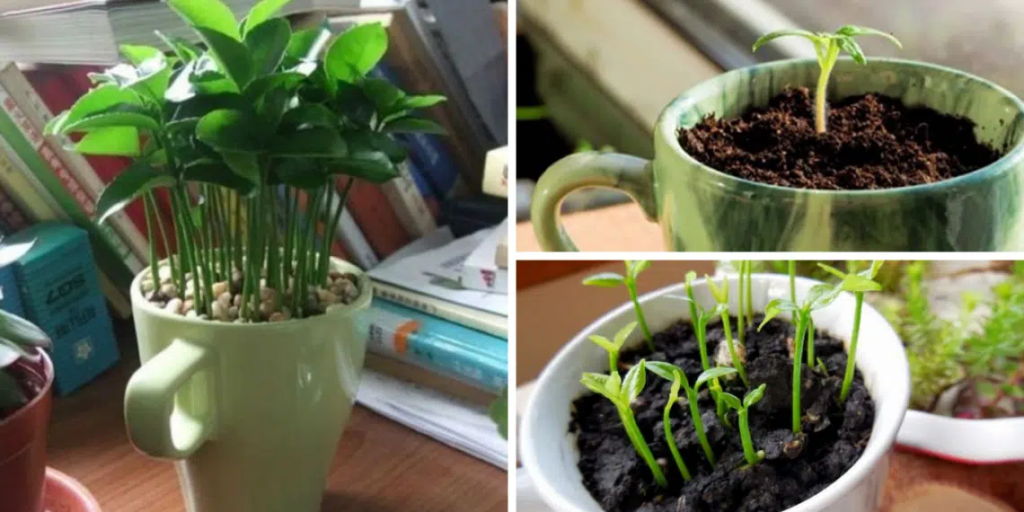
Lemons are not only delicious and healthy but also a fantastic addition to your home garden.
Planting a lemon seed in a cup is a simple and rewarding way to grow a small indoor lemon plant that can freshen your home and elevate your mood.
The citrusy aroma of lemon plants has natural stress-relieving properties, and their bright green foliage adds a touch of nature to any indoor space.
Here’s a detailed step-by-step guide on how to plant a lemon in a cup, care for it, and enjoy its benefits in your home.
Benefits of Growing a Lemon Plant Indoors
- Natural Air Freshener: The subtle citrus fragrance of a lemon plant naturally freshens your home.
- Mood Booster: The scent of lemons is scientifically proven to reduce stress, boost energy, and improve focus.
- Decorative Touch: Lemon plants add a vibrant, refreshing aesthetic to your living space.
- Educational: Growing a lemon plant is a fun and educational project for kids and adults alike.
What You’ll Need
To grow a lemon in a cup, you’ll need the following items:
- Fresh lemon seeds (from an organic lemon, if possible).
- A small cup or container (ceramic, plastic, or glass with drainage holes).
- Potting soil (light, well-draining soil mixed with sand or perlite).
- Plastic wrap or a small plastic bag.
- A spray bottle for watering.
- A sunny location indoors.
Step-by-Step Guide to Planting a Lemon in a Cup
Step 1: Choose Fresh Seeds
- Use seeds from a fresh, organic lemon for the best results.
- Rinse the seeds under lukewarm water to remove any pulp, as leftover pulp can cause mold or rot.
Pro Tip: Plant the seeds immediately after removing them from the lemon to maximize their viability.
Step 2: Prepare the Cup
- Choose a small cup or container with drainage holes to prevent waterlogging.
- If the cup doesn’t have drainage holes, add a layer of small stones or pebbles at the bottom to allow water to drain.
Step 3: Fill the Cup with Soil
- Use well-draining potting soil to ensure the seed doesn’t sit in overly wet conditions.
- Fill the cup about ¾ full with soil, leaving space for the seed and additional soil to cover it.
Pro Tip: A soil mix with added sand or perlite works best for citrus plants.
Step 4: Plant the Seed
- Place the lemon seed about ½ inch deep into the soil.
- Cover it with a thin layer of soil, ensuring it’s lightly packed but not too dense.
Step 5: Water the Soil
- Use a spray bottle to lightly mist the soil. Avoid overwatering, as lemon seeds need consistent but not soggy moisture to germinate.
- Keep the soil evenly moist throughout the germination process.
Step 6: Create a Mini Greenhouse
- Cover the cup with plastic wrap or a small plastic bag to trap moisture and create a greenhouse effect.
- Poke a few small holes in the plastic wrap to allow airflow.
Pro Tip: Place the cup in a warm spot with indirect sunlight to encourage germination.
Step 7: Wait for Germination
- Lemon seeds typically take 2–3 weeks to germinate. Be patient and keep the soil consistently moist during this time.
- Once you see a small sprout emerging from the soil, remove the plastic cover and place the cup in a sunny location.
Caring for Your Lemon Plant
1. Light Requirements
- Lemon plants thrive in bright, indirect sunlight. Place the cup near a sunny window that receives at least 6–8 hours of light daily.
- If natural light is limited, consider using a grow light.
2. Watering
- Keep the soil consistently moist but avoid overwatering.
- Use a spray bottle or a watering can with a fine spout to prevent disturbing the soil around the plant’s roots.
3. Temperature and Humidity
- Lemon plants prefer warm temperatures between 65–75°F (18–24°C).
- Increase humidity by misting the plant or placing a small tray of water nearby.
4. Fertilizing
- Once the plant has grown a few inches tall, feed it with a balanced liquid fertilizer (diluted to half strength) every 4–6 weeks during the growing season.
Benefits of a Lemon Plant in Your Home
1. Natural Air Freshener
The fresh, citrusy aroma of a lemon plant can neutralize odors and purify indoor air.
2. Stress Relief
The scent of lemons is known to reduce stress and anxiety, making your home a calming and uplifting environment.
3. Health Benefits
Lemon plants release oxygen and moisture, improving air quality and promoting better respiratory health.
4. Decorative Appeal
A vibrant green lemon plant adds a lively, tropical touch to any room.
Troubleshooting Common Problems
1. Yellowing Leaves
- Cause: Overwatering or nutrient deficiency.
- Solution: Allow the soil to dry slightly between waterings and feed the plant with a balanced fertilizer.
2. Mold on Soil
- Cause: Excessive moisture or poor airflow.
- Solution: Remove moldy soil and reduce watering. Ensure the plant is in a well-ventilated area.
3. Slow Growth
- Cause: Insufficient light or poor soil quality.
- Solution: Move the plant to a sunnier location and ensure the soil is nutrient-rich.
When to Repot Your Lemon Plant
As your lemon plant grows, it will eventually outgrow the cup. Repot it into a larger container when:
- The roots are visible through the drainage holes.
- Growth appears stunted despite proper care.
Choose a pot that is 2–3 inches larger in diameter and use the same well-draining soil mix.
Planting a lemon seed in a cup is a simple and enjoyable way to bring nature indoors.
Not only does it provide a natural air freshener and mood booster, but it also serves as a beautiful, low-maintenance addition to your home.


